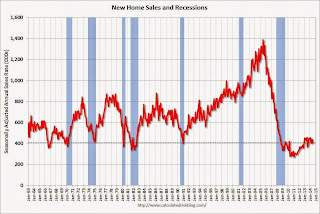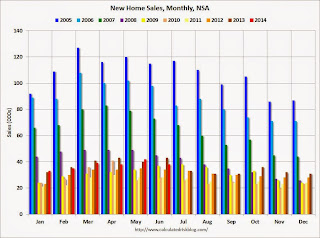by Calculated Risk on 7/24/2014 03:45:00 PM
Thursday, July 24, 2014
NMHC Survey: Apartment Market Conditions Tighter in Q2 2014
From the National Multi Housing Council (NMHC): Apartment Markets Continue Expansion in July NMHC Quarterly Survey
Apartment markets continued to expand in the second quarter of 2014, as growth accelerated in all four indexes in the National Multifamily Housing Council (NMHC) Quarterly Survey of Apartment Market Conditions. The market tightness (68), sales volume (56), equity financing (58) and debt financing (68) indexes all improved from the first quarter this year and marked the second quarter in a row with all above the breakeven level of 50.
“Despite concerns in some quarters about the pace of new development, most markets appear to be absorbing new supply with no downward pressure on rents or vacancies,” said NMHC Senior Vice President of Research and Chief Economist Mark Obrinsky. “The improvement in market tightness was particularly noteworthy. Four years into the apartment industry recovery and expansion, the increase in demand continues to outstrip the pickup in new supply.”
The survey also asked about urban vs. suburban development. Four in ten (43 percent) reported an increased share of urban development relative to suburban in the last six months, compared to one quarter (27 percent) reporting an increased share of suburban development. Of the suburban development taking place, more than half (54 percent) reported more town center-style developments, with 39 percent reporting no appreciable change and 7 percent reporting more garden-style developments. [These results exclude “Don’t know/not applicable.”]
“Early in the recovery, apartment development was concentrated in downtown areas of large cities. While such areas continue to attract investment, new construction is expanding more broadly into suburbs as well. But developers are bringing urban style to suburban locations, with a heavier emphasis on ‘town center’ communities than we’ve seen in the past,” said Obrinsky.
...
The Market Tightness Index rose from 56 to 68. The percentage of respondents who saw looser conditions continued to decline, down from 20 percent to 15 percent. While this improvement is partly seasonal, the index is higher than the average for the July quarter since the survey began 15 years ago.
emphasis added

Click on graph for larger image.
This graph shows the quarterly Apartment Tightness Index. Any reading above 50 indicates tighter conditions from the previous quarter. This indicates tighter market conditions.
As I've mentioned before, this index helped me call the bottom for effective rents (and the top for the vacancy rate) early in 2010. The apartment market is still solid right now.
Comments on the New Home Sales report
by Calculated Risk on 7/24/2014 12:31:00 PM
The new home sales report for June - combined with the downward revisions for previous months - was very weak.
The Census Bureau reported that new home sales this year, through June, were 225,000, Not seasonally adjusted (NSA). That is down 4.3% from 235,000 during the first half of 2013 (NSA).
Maybe sales will move sideways for a little longer, but remember early 2013 was a difficult comparison period. Annual sales in 2013 were up 16.3% from 2012, but sales in the first four months of 2013 were up 26% from the same period in 2012!
 Click on graph for larger image.
Click on graph for larger image.
This graph shows new home sales for 2013 and 2014 by month (Seasonally Adjusted Annual Rate).
The comparisons to last year will be a little easier in Q3, and I still expect to see year-over-year growth later this year.
And here is another update to the "distressing gap" graph that I first started posting several years ago to show the emerging gap caused by distressed sales. Now I'm looking for the gap to close over the next few years.
 The "distressing gap" graph shows existing home sales (left axis) and new home sales (right axis) through June 2014. This graph starts in 1994, but the relationship has been fairly steady back to the '60s.
The "distressing gap" graph shows existing home sales (left axis) and new home sales (right axis) through June 2014. This graph starts in 1994, but the relationship has been fairly steady back to the '60s.
Following the housing bubble and bust, the "distressing gap" appeared mostly because of distressed sales.
I expect existing home sales to decline or move sideways (distressed sales will slowly decline and be partially offset by more conventional / equity sales). And I expect this gap to slowly close, mostly from an increase in new home sales.
Note: Existing home sales are counted when transactions are closed, and new home sales are counted when contracts are signed. So the timing of sales is different.
Kansas City Fed: Regional Manufacturing "Activity Edged Higher" in July
by Calculated Risk on 7/24/2014 11:00:00 AM
From the Kansas City Fed: Growth in Tenth District Manufacturing Activity Edged Higher
The Federal Reserve Bank of Kansas City released the July Manufacturing Survey today. According to Chad Wilkerson, vice president and economist at the Federal Reserve Bank of Kansas City, the survey revealed that growth in Tenth District manufacturing activity edged higher, and producers’ optimism for future activity increased.The last regional Fed manufacturing survey for July will be released on Monday, July 28th (the Dallas Fed). All of the regional surveys so far have indicated stronger growth in July than in June and - in general - the strongest growth in several years.
“Factories in our region reported slightly faster growth in July,” said Wilkerson. “In addition, future hiring and capital spending plans were the highest in six months.”
The month-over-month composite index was 9 in July, up from 6 in June but slightly lower than 10 in May. The composite index is an average of the production, new orders, employment, supplier delivery time, and raw materials inventory indexes. ... The production index climbed from 2 to 11, and the shipments, new orders [to 12], and employment indexes [from 1 to 8] also rose considerably.
emphasis added
New Home Sales decrease to 406,000 Annual Rate in June
by Calculated Risk on 7/24/2014 10:00:00 AM
The Census Bureau reports New Home Sales in June were at a seasonally adjusted annual rate (SAAR) of 406 thousand.
May sales were revised down from 504 thousand to 442 thousand, and April sales were revised down from 425 thousand to 408 thousand.
Sales of new single-family houses in June 2014 were at a seasonally adjusted annual rate of 406,000, according to estimates released jointly today by the U.S. Census Bureau and the Department of Housing and Urban Development. This is 8.1 percent below the revised May rate of 442,000 and is 11.5 percent below the June 2013 estimate of 459,000.
 Click on graph for larger image.
Click on graph for larger image.The first graph shows New Home Sales vs. recessions since 1963. The dashed line is the current sales rate.
Even with the increase in sales over the previous two years, new home sales are still close to the bottom for previous recessions.
The second graph shows New Home Months of Supply.
 The months of supply increased in June to 5.8 months from 5.2 months in May.
The months of supply increased in June to 5.8 months from 5.2 months in May. The all time record was 12.1 months of supply in January 2009.
This is now in the normal range (less than 6 months supply is normal).
"The seasonally adjusted estimate of new houses for sale at the end of June was 197,000. This represents a supply of 5.8 months at the current sales rate."
 On inventory, according to the Census Bureau:
On inventory, according to the Census Bureau: "A house is considered for sale when a permit to build has been issued in permit-issuing places or work has begun on the footings or foundation in nonpermit areas and a sales contract has not been signed nor a deposit accepted."Starting in 1973 the Census Bureau broke this down into three categories: Not Started, Under Construction, and Completed.
The third graph shows the three categories of inventory starting in 1973.
The inventory of completed homes for sale is still low, and the combined total of completed and under construction is also low.
 The last graph shows sales NSA (monthly sales, not seasonally adjusted annual rate).
The last graph shows sales NSA (monthly sales, not seasonally adjusted annual rate).In June 2014 (red column), 38 thousand new homes were sold (NSA). Last year 43 thousand homes were also sold in June. The high for June was 115 thousand in 2005, and the low for June was 28 thousand in 2010 and 2011.
This was well below expectations of 475,000 sales in June, and sales were down 11.5% year-over-year.
I'll have more later today .
Weekly Initial Unemployment Claims decrease to 284,000, 4-Week Average Lowest since May 2007
by Calculated Risk on 7/24/2014 08:30:00 AM
The DOL reports:
In the week ending July 19, the advance figure for seasonally adjusted initial claims was 284,000, a decrease of 19,000 from the previous week's revised level. This is the lowest level for initial claims since February 18, 2006 when they were 283,000. The previous week's level was revised up by 1,000 from 302,000 to 303,000. The 4-week moving average was 302,000, a decrease of 7,250 from the previous week's revised average. This is the lowest level for this average since May 19, 2007 when it was 302,000. The previous week's average was revised up by 250 from 309,000 to 309,250.The previous week was revised up to 303,000.
There were no special factors impacting this week's initial claims.
The following graph shows the 4-week moving average of weekly claims since January 1971.
 Click on graph for larger image.
Click on graph for larger image.The dashed line on the graph is the current 4-week average. The four-week average of weekly unemployment claims decreased to 302,000.
This was lower than the consensus forecast of 310,000. The 4-week average is now at normal levels for an expansion.


